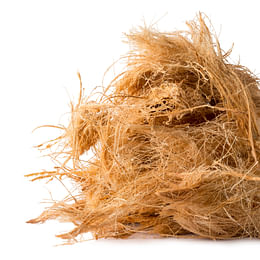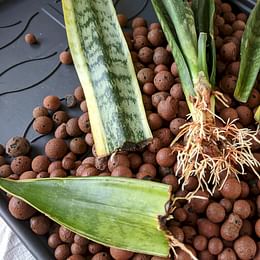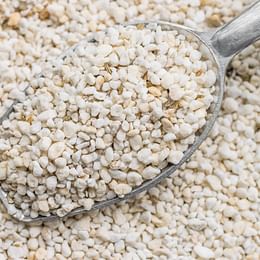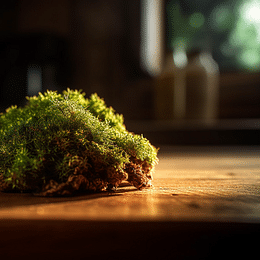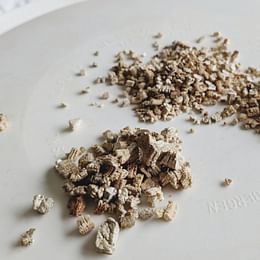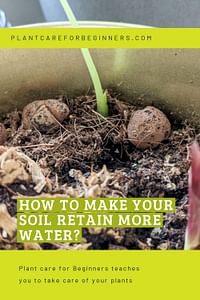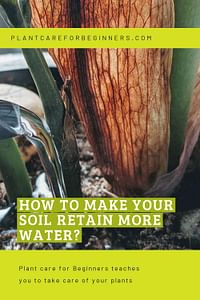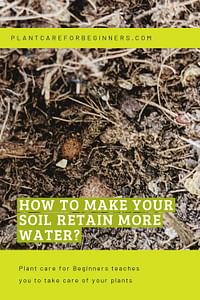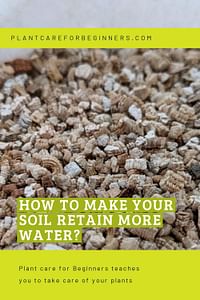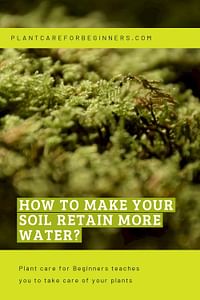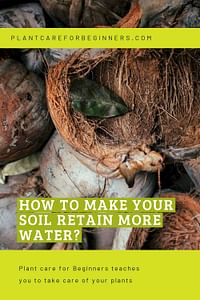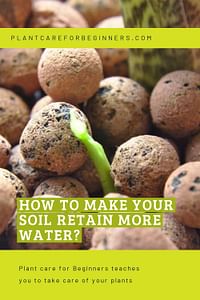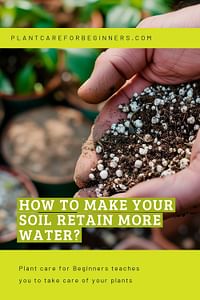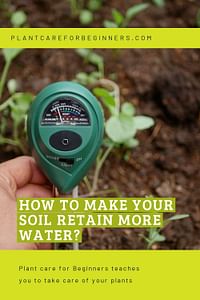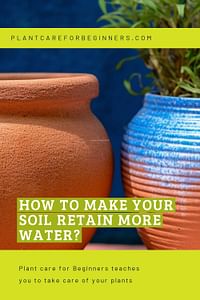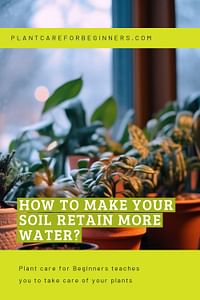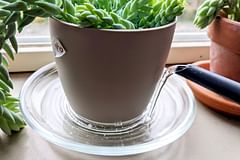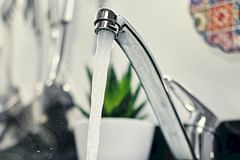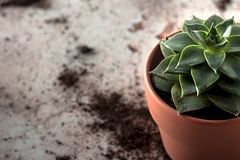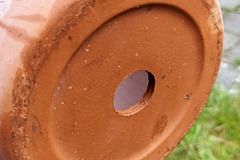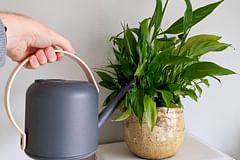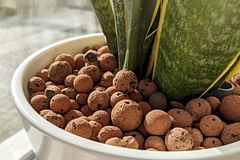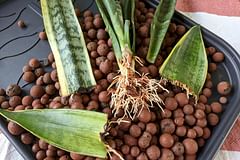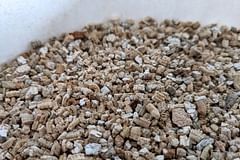How to make your soil retain more water?
Moisture-loving plants thrive in soil that's moist most of the time. But how do you make sure your soil is moist without attracting pests or overwatering your plant? In this plant care guide, we're going to look at several ways you can improve the water retention of your soil to help your plants thrive.
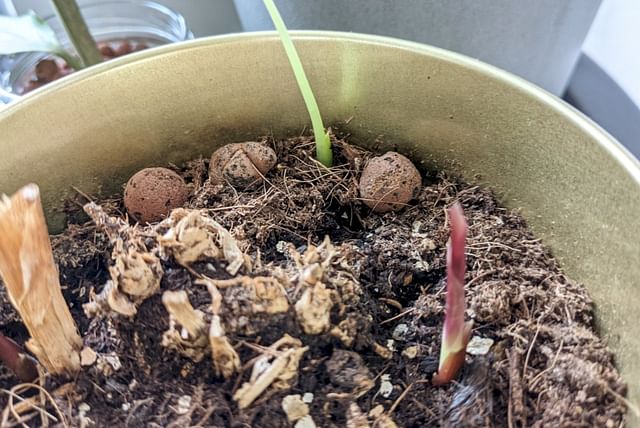
Some plants love moisture and love to be in soil that keeps them moist at all times.Sounds like quite an easy thing to do: just water your plants more often. This works really well in the short term, but isn't a great long-term solution.
What if you go on vacation and you can't water your plant for 2 weeks? How do you make sure your soil is moist without attracting pests or over-watering your plant?
In this plant care guide, we're going to look at how we can improve our soil and hold more moisture. We'll also explain why simply watering your plant more often isn't a great long-term solution. There are much better, more sustainable ways that will make your plant happy and help it thrive.
These are the things we're going to look at:
- Why is watering more often not a long-term solution?
- How to make the perfect soil for moisture-loving plants?
- The ingredients
- What is Vermiculite and how can you use it?
- Sphagnum moss (and peat moss)
- Coconut coir
- Excellent drainage for moisture-loving plants
- What is the best ratio of soil ingredients for different types of plants like succulents vs. tropical plants?
- How can adding mulch on top of soil help with moisture retention?
- Watering techniques for retaining more moisture
- How to test soil moisture
- What type of pot helps your plants retain moisture better?
- How do humidity and temperature affect soil moisture?
- How do seasonal changes affect soil moisture, and what adjustments should you make?
- Conclusion
Let's get into the reason why watering more often isn't a long-term solution for your moisture-loving plants.
Why is watering more often not a long-term solution?
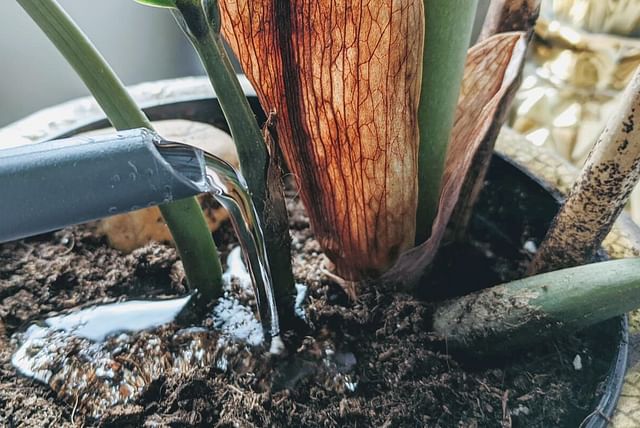
Watering your plant more often to give it more moisture isn't a good long-term solution. But why not? Here are 3 reasons!
1. Your plant relies on you
When you water your plant more often and that's the only way your plant gets enough moisture, it relies on you being there.
If you, for any reason, can't water your plant for more than a week at a time, your plant will dry out and die. You can't go on vacation without having to worry about your plants dying while you're away. That's something all plant owners have worried about at some point, but it doesn't have to be that way any more.
2. Soil compacts over time
Another reason watering more often isn't a great way to keep your plant healthy is the fact that soil compacts over time.
When you water your plant often, the soil will compact and become dense.
Most houseplants don't do very well in dense soil, because it doesn't allow as much oxygen to get to your plant's roots. When your plant's roots don't get enough oxygen, it might cause root rot. Dense soil also doesn't drain the excess moisture away very well.
This is the perfect place for fungi to grow.
3. Accidentally over-watering
When you water your plants more often, you could accidentally over-water it. Plants don't respond to watering issues right away; it takes them a few days to react. If you accidentally misread your plant and water it more than you should have, you're at risk of over-watering your plant.
If you can extend the time between watering, you run a much lower chance of making mistakes. You can see how your plant responds over a few days and see if you need to change your plant care routine.
How to make the perfect soil for moisture-loving plants?
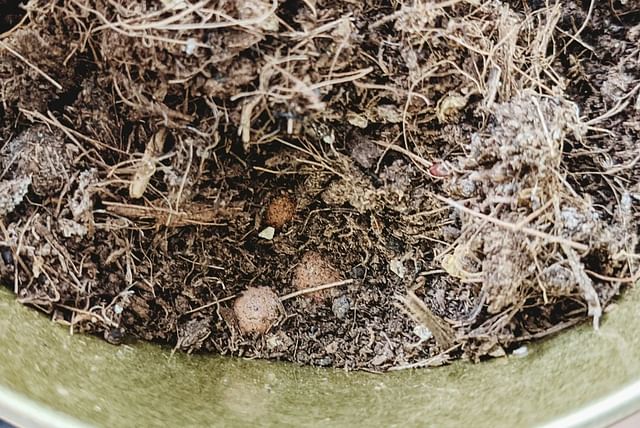
Simply watering your plants more often doesn't work in the long term, but what does? There are many great ways to help your soil retain more moisture, while keeping your plant happy.
First, we'll need to determine what the perfect soil for moisture-loving plants is and does. The perfect soil for your moisture-loving plants should:
- Keep the soil moist for multiple days
- Keep it's structure to prevent the soil from becoming compact
- Let excess water drain away quickly
This soil will stay the right moisture level for your plants, without over-watering it. It will also make sure plenty of oxygen can reach your plant's roots. But talk is cheap, lets see how we can do this!
The ingredients
In this section, we're going to look at which ingredients you'll need for your soil. By adding these ingredients, your soil holds onto moisture for longer, without risking the health of your plant. You'll need any one of these ingredients to retain more moisture:
- Vermiculite
- Sphagnum (peat) moss
- Coconut coir
You don't have to use all 3 ingredients. Using 1 or 2 of these ingredients is enough for your soil. You'll also want to add ingredients to improve drainage, any one of these is great:
- Perlite
- Leca
- Grainy sand
Now, we'll look at what each of these things are and how it can help you to retain more moisture in your soil. Afterwards, you'll be able to choose which one you want to use.
What is Vermiculite and how can you use it?
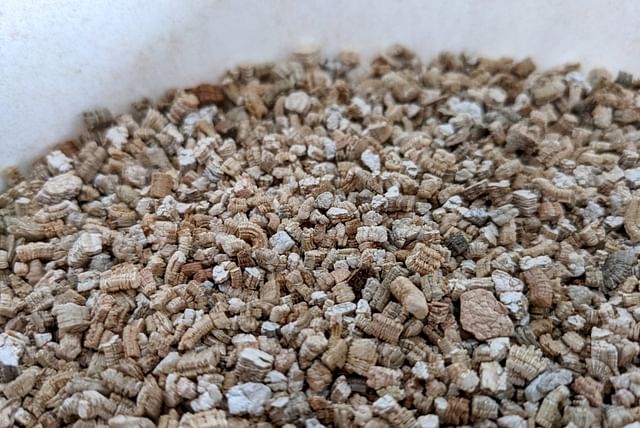
Vermiculite is a naturally occurring mineral that's heated until it expands and forms into lightweight particles. It's a material that's naturally resistant to mold and other diseases and can hold a lot of moisture. It's sterile, non-toxic and will never go bad. This means that it's great for long-term use with your moisture-loving plants.
You can use this with your soil by mixing it in, just like you would with Perlite. It's quite cheap and you can find it at almost all gardening centers, or through a link at the bottom of this post. Vermiculite is not a natural growing medium for plants, so it also doesn't contain any nutrients to help your plants grow. You'll need to add these nutrients through soil and fertilizer.
Vermiculite retains a lot of water, so when you're mixing this with soil, be sure to not add too much of it. A good measurement is 1/6 Vermiculite, 2/6 leca/perlite/sand, and 3/6 soil.
Advantages: Sterile, resistant to mold, doesn't go bad
Sphagnum moss (and peat moss)
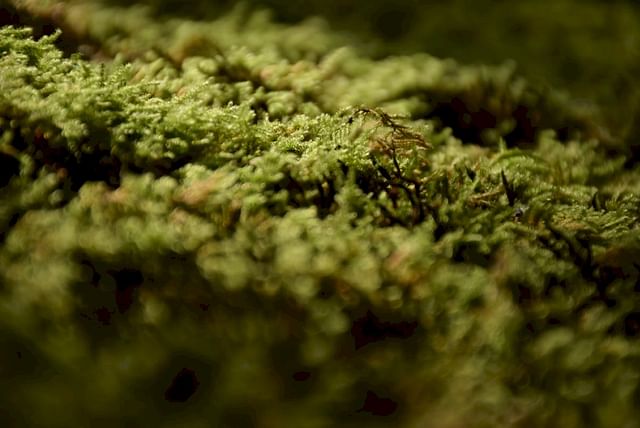
Sphagnum moss and Peat moss are both the same type of moss: both are dead and dry. The only difference between the two is the way they're collected. Peat moss is collected as dead moss from the ground and Sphagnum moss is collected as live plants and then dried.
If you have a plant that's fine with more acidic soil, you can use peat moss to retain extra moisture in your soil. But if your plant needs more neutral soil, adding Sphagnum moss adds the water retention properties you need.
You can use both of these types of moss by mixing it in with the soil. The chunks of moss will retain moisture quite easily, while also giving the soil some structure. This helps to prevent compacting soil. Moss is a natural product, so it does contain a few nutrients to help your plants grow. Most of the nutrients will come in through the soil and any fertilizer though.
If you want to use Sphagnum moss in your soil, you can add about 1/3 moss, 1/3 soil, and 1/3 leca/perlite/sand.
Advantages: Anti-bacterial, anti-fungal properties, pH neutral
Coconut coir
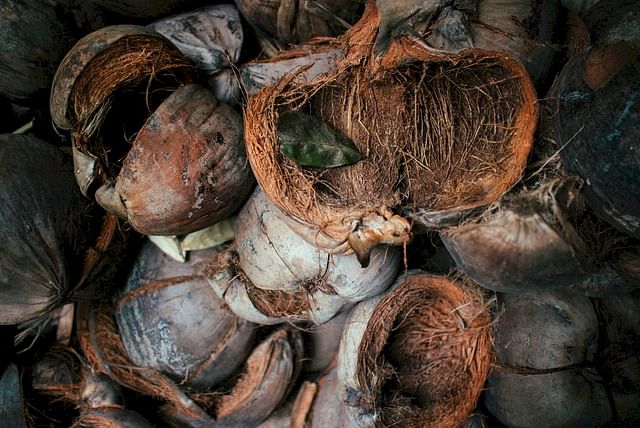
Coconut coir is a "waste product" of coconuts. It's a great addition to your soil if you're looking to improve the water retention.
When you add this to your soil, you're adding fibers to improve the structure of your soil. The fibers keeps each other in place quite well, so that will help to prevent your soil from compacting.
Besides these very practical advantages, coconut coir also protects your soil and plant against diseases. It's a clean product that improves the water retention, without attracting mold.
Like Vermiculite, Coconut coir itself doesn't contain any nutrients for your plants. This means that you'll have to add it to something that does, like soil. If you're going to use coconut coir to improve the water retention of your soil, you'll need to add perlite, sand, or Leca to improve drainage. The coir doesn't drain well and could cause problems if you don't add enough drainage.
As a rule of thumb, use 1/3 soil, 1/3 coconut coir, and 1/3 perlite/leca/sand.
Advantages: Protection against diseases, optimal pH level for nutrient intake
Excellent drainage for moisture-loving plants
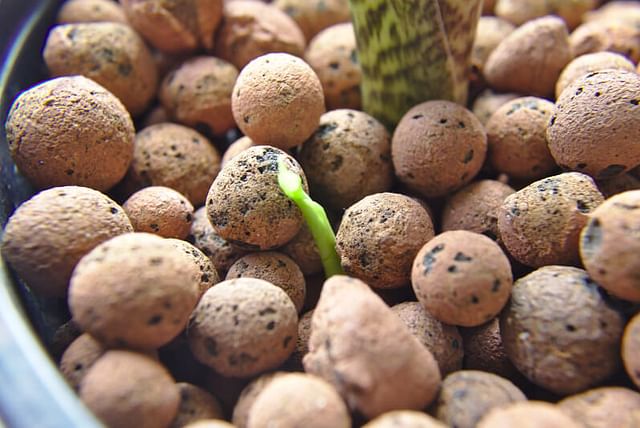
Perlite, Leca, and sand are ingredients for your soil to improve drainage.
This might sound strange as an ingredient for soil that you'd want to improve the water retention of, but there is a good reason. When you add Vermiculite, Sphagnum moss, and/or Coconut coir, you add material to your soil that hold on to a lot of water. This soil will want to compact to retain as much moisture as possible.
This is bad for drainage, because the excess moisture will stay behind in the soil. Which is why you need to break up the soil into draining and retaining pockets. You can do this by adding Leca, Perlite, or Sand to your soil mixture.
The Leca, Perlite, and sand make sure that any excess water is quickly draining to the bottom of the pot. Leca and Perlite also help to keep the shape of your soil to prevent the soil from compacting. It can do this, because Leca and Perlite are quite large, unlike sand.
By breaking up your soil, you prevent over-watering and allow the flow of oxygen to the plant's roots.
You can use Perlite, Leca, or Sand, any of these choices works well and you can pick the one you prefer.
If you'd like to learn more about improving drainage of your soil, including other ways not mentioned here, have a look at "How to make your soil drain water quickly?".
What is the best ratio of soil ingredients for different types of plants like succulents vs. tropical plants?
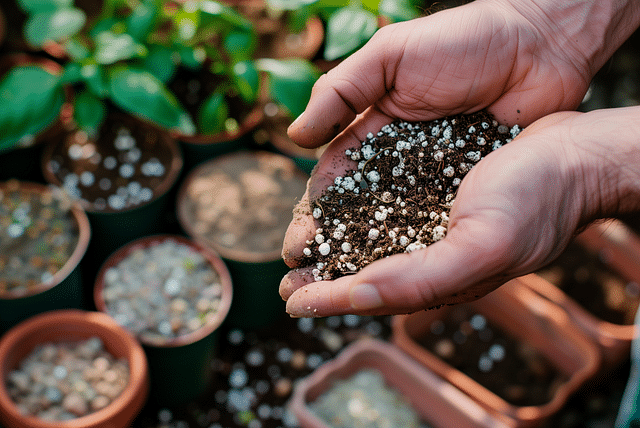
The toughest part of creating your own soil mixes is finding the right ratios. To make it even tougher: not all plants like the same ratios. For example, tropical plants like to keep the soil more moist, while succulents need dry soil to stay healthy.
In this section, I'll give you the optimal ratios for both types of plants. This should give you a good starting point when you want to experiment with your own plants.
For succulents, which love dry soil, a well-draining soil mix is very important. I recommend to start with 50% potting soil, 25% perlite or coarse sand, and 25% pumice or gravel. This mixture allows excess water to drain quickly. The soil still holds onto some moisture to water your succulent, but the other half of the soil is great at draining the rest of it. The sandy texture of the soil is very similar to their natural desert habitat.
On the other hand, tropical plants require a slightly different soil composition that retains moisture while still providing enough drainage. A good mix for these plants usually consists of 60% potting soil, 20% coconut coir or peat moss, and 20% perlite or orchid bark.
This mixture retains moisture without becoming waterlogged and compacting too much, which makes it easy for your plant's roots to grow into the soil. The coconut coir or peat moss helps hold onto moisture and nutrients, creating a more humid environment that is much like their native habitats.
How can adding mulch on top of soil help with moisture retention?
If you have a garden in a very dry environment, you might have heard about using mulch to retain moisture in the soil. Did you know you can also do this for houseplants?
Adding mulch to your plant's soil can be a game-changer when it comes to retaining moisture. Mulch helps by becoming as a protective layer that prevents much of the moisture in the soil of your plant from evaporating. This can be very helpful during the hotter days in the summer, but is also really useful in the winter. In the winter, central heating tends to dry out the air in your house and also dries out your plant's soil.
By covering the soil surface, mulch creates a barrier that prevents direct sunlight and wind from drying it out too quickly. This also means that the soil stays consistently moist for longer periods. This can be a nice little trick to use if you're planning to be away from home for a while.
Since mulch prevents the soil from reaching the soil, it can also help to keep your plant a little cooler in the summer, but also slightly warmer in the winter. In short, it can help to keep your plant more comfortable.
If you're using an organic mulch, it also helps to feed your plant as it breaks down over time. So this slow release of nutrients doesn't just help your plant, but it also improves the soil overall.
Watering techniques for retaining more moisture
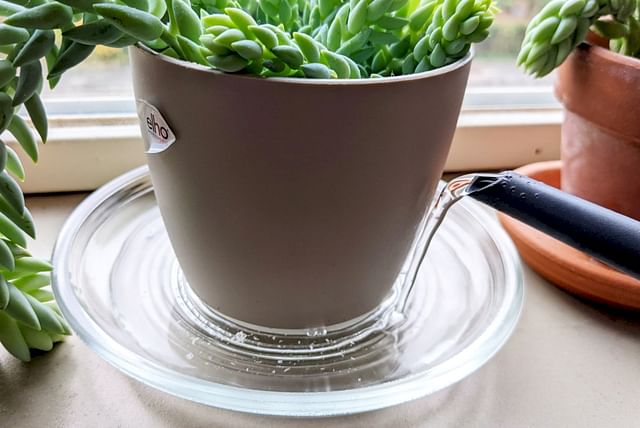
You might be looking at this header and think to yourself, what impact can a watering technique have on how much moisture is retained in the soil. You'd be surprised!
Deep watering
The first technique is watering your plant deeply and not very often rather than giving your plants light, frequent watering. Deep watering encourages the roots to grow deeper into the soil in search of moisture, which leads to stronger, tougher plants.
To deep water, use enough water so that the soil at all depths in your pot can absorb the moisture. Not just at the top. This not only helps to water your plant more evenly, but it also keeps it hydrated for longer. If you only water the top of the soil, it'll evaporate quickly and the soil will be dry again.
A super easy way to deep water is by bottom-watering your plant. This lets the soil absorb moisture from the bottom and slowly spread it throughout the pot.
Water in the morning or evening
Another easy way to make sure the soil is moist for longer is by watering your plant during the cooler parts of the day, such as early morning or late afternoon. When you water during these times, the moisture won't evaporate as quickly by the sun's intense heat.
Always check the moisture levels of the soil before watering to prevent watering your plants too much. We'll look at how to check the soil in the next sections. If you're dealing with extreme temperature changes during the day, you could consider moving your plant to a more stable spot, or try using some mulch to control the soil temperature.
How to test soil moisture
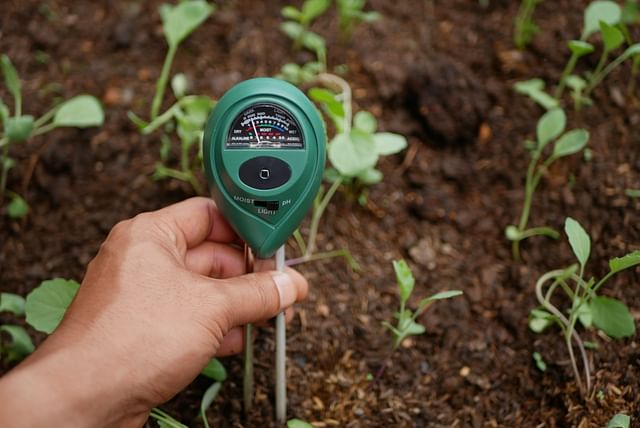
If you're not quite sure if your plant is still hydrated before you water your plant, you can test this using a few simple tricks. Knowing whether your soil is too dry or too wet helps you avoid issues like root rot or dehydration. Here are some simple methods to check soil moisture effectively:
Finger test
Insert your index finger about 2-5 cm (1-2 inches) into the soil. If the soil feels dry at that depth, your plant needs watering. If it feels moist, it's best to wait a few more days before watering again.
Soil moisture meter
For a more hightech approach, purchase a moisture meter from a garden store or online. Insert the probe into the soil according to the package instructions, and check the reading on the meter, which will indicate if the moisture level is low, optimal, or high.
Weight test
The weight test is my favorite. You do this test by watering your plant thoroughly and allow it to drain. When the water is no longer draining from the pot, weigh the plant or pot. You can do this using a scale or just by lifting it up and remembering the weight. After a week or so, lift the pot again. It'll feel a lot lighter and this is the weight you'll look for next time when testing if your plant needs water.
Visual inspection
You can also look for clues in the soil to tell you if the plant should be watered. Look for signs such as wilting leaves or curling of the leaf edges and check for cracks in the soil surface; these cracks can mean the soil is too dry. If you see water on top or in the soil, the soil might be too wet and you might have to check if your pot is still draining the moisture well enough.
What type of pot helps your plants retain moisture better?
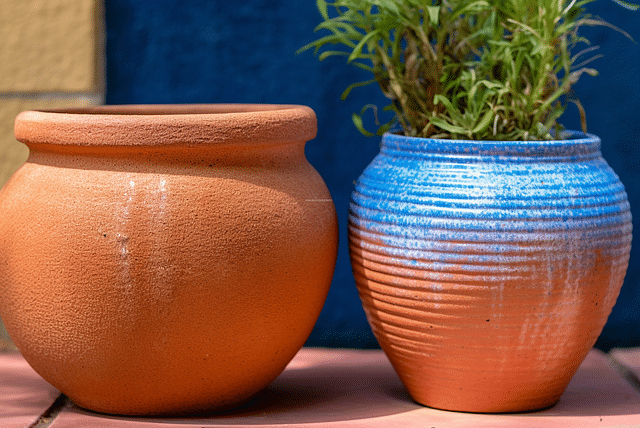
Along with keeping an eye on watering and creating the best soil, choosing the right pot for your plants is also important. The type of pot you use can also impact how well your soil stays hydrated and how your plants’ roots develop.
Pots made from materials such as plastic or glazed ceramic are the best for moisture retention. These types of pots are usually non-porous, meaning the moisture in the soil stays in the soil rather than evaporating.
Terracotta and ceramic (non-glazed) pots are porous, allowing air and moisture to flow through the walls of the pot, which helps prevent over-saturation of the soil. These types of pots dry out more quickly than non-porous pots, because the moisture can freely evaporate. These types of pots are perfect for plants that are sensitive to overwatering, because the pot helps to dry the soil more quickly.
How do humidity and temperature affect soil moisture?
Humidity and temperature are crucial for keeping your plants healthy. They directly impact how quickly water evaporates from the soil, which influences how often you need to water.
Humidity
High humidity means less evaporation, so your soil stays moist longer, requiring less watering. In low humidity, evaporation speeds up, and you risk drying out your plants if you don't water more often.
You can increase the humidity by using a humidifier, grouping plants together to boost humidity, or placing a tray with water and pebbles under your pots to create a moist environment. For more tips, check out my other guide 10 ways to raise the humidity in your house.
Temperature
Warmer temperatures increase evaporation, leading to quicker drying out of soil. Cooler temperatures slow it down, letting soil retain moisture. But temperatures that go too low could stop your plant from being able to absorb water, so make sure your plant doesn't get exposed to temperatures below 16 degrees Celsius (60 F).
You can manage the temperature a little better by placing plants where they get proper light without extreme heat. Avoid placing them near heating vents or in direct sunlight during the hottest hours. Use shades if needed, and adjust watering based on seasonal changes.
How do seasonal changes affect soil moisture, and what adjustments should you make?
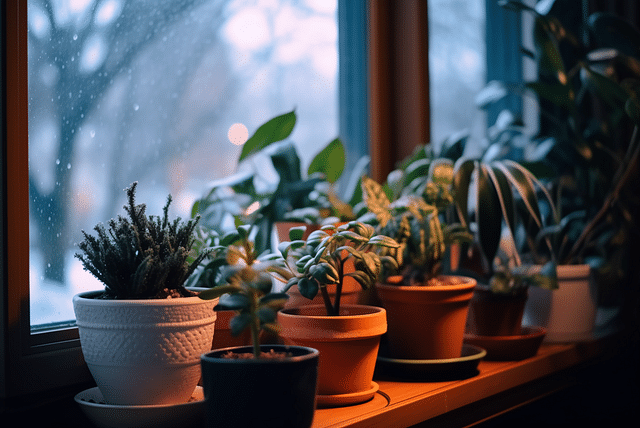
Seasonal changes have a huge impact on how often you should water your plant. Temperature, humidity, and rainfall (if you're going outside) all influence how much moisture your soil retains, so you need to change your watering routine during the year.
Spring and summer: Warmer weather and more sunlight increase evaporation, making the soil dry faster. During these seasons, you should water your plants more often. Keep an eye on your soil, check for dryness and adjust your watering schedule to meet your plants' needs.
Fall and winter: The cooler temperatures and shorter days lower evaporation rates. Many plants become dormant and need less water. So you should scale back your watering to once a week or every two weeks, depending on the type of plant and local conditions. Be mindful of indoor humidity, as central heating can dry the air. Consider using a humidifier or misting your plants to maintain moisture.
Conclusion
When you give your moisture-loving plants the moisture they want, they'll be happy plants for a long time. There are a few ways to keep your plants happy with long-term solutions. These long-term solutions help you feel at ease, but also help your plants thrive.
You can improve the water retention properties of your soil by adding vermiculite, sphagnum (peat) moss, and/or coconut coir. When you make the soil retain more moisture, you'll also need to improve the drainage to prevent any watering issues. You can improve the drainage by adding perlite, Leca, and sand to your soil. A combination of these ingredients will make sure your plants are always in the soil they love: a lot of moisture, but not wet; plenty of oxygen to prevent pests, and plenty of nutrients to grow with.
Thank you for reading this post! I hope it helps you to keep your plants healthy and beautiful! If you're looking for more guides on specific plants, you can always request a plant guide to get a guide for the plant you have trouble with.
Test your plant care knowledge
Quiz completed!
Want to learn more? Sign up for my newsletter to receive free tips in your inbox!
Sign up now!